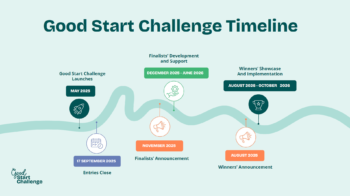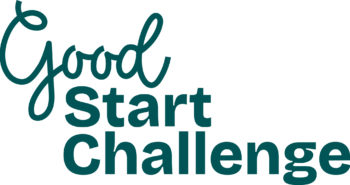About the Challenge
The Good Start Challenge is a €2.6 million global challenge to advance innovative solutions to improve the wellbeing of parents and other caregivers of young children in disadvantaged circumstances across Brazil, Colombia, Mexico, Ethiopia, Kenya, Senegal, Uganda, the Philippines and Indonesia.
Why this Challenge is important
Becoming a parent is a time of transformation and – often – vulnerability. Yet many parents, especially those in disadvantaged circumstances, are unable to access the support needed for better mental and physical wellbeing. Evidence and initiatives for supporting parental wellbeing have started to emerge across the globe, but more can be done to translate that knowledge into practice and replicate more widely so that every parent can have the good start they deserve.
This Challenge calls for innovative solutions that build and deepen the wellbeing of caregivers from pregnancy and the first years of parenthood in nine countries.
The Good Start Challenge is looking for teams that can:
Advance innovative solutions to improve the wellbeing of parents and other caregivers of young children from marginalised communities, including:
- Single parents
- Adolescent parents
- Parents affected by displacement and migration
- Parents in financially vulnerable situations
- Pregnant women, mothers, and women primary caregivers
For details on the focus of the Challenge in your specific region, see the dedicated pages for Latin America, Sub-Saharan Africa and Southeast Asia.
What might solutions look like?
We are excited to see a variety of models and approaches combining expertise and finding creative ways to serve parents more effectively and more widely. These could include services, physical products, or digital solutions.
For example, we would love to see solutions which:
- Empower parents to tap into and feel confident in their own parental knowledge and instincts;
- Enable parents to work, learn, move, access services and conduct other activities, with or without their children present;
- Use the power of public policy and services to reach parents and caregivers;
- Foster connections and support networks among parents and other caregivers;
- Build bonds among parents and between parents and their babies;
- Are adapted from existing solutions in order to address the specific needs of caregivers living in disadvantaged settings;
- Enable parents and caregivers to use creativity and joy to deepen their own wellbeing; and,
- Leverage technology to reach more families.
For inspiration, we challenge you to consider:
- How could public transportation be designed to serve mothers and fathers better?
- How can we make it easier for parents to access public services with young children present?
- What could be designed to give parents an extra hand when caring for their babies alone?
- How can we make it easier for parents in marginalised communities to work, gain education or build career opportunities?
- How can we help pregnant women or new parents look after their mental health and wellbeing?
- How can we help parents in marginalised communities better access affordable support services and manage their finances?
- How can we help parents get more sleep and exercise?
- What can we do to better support parents’ physical and spiritual wellbeing?
- How could we encourage creativity and play to support parental wellbeing and strengthen bonds with their children?
Key Challenge information
-
Who should enter?
Parents come into contact with a wide range of services and sectors everyday, all of which have potential to drive bold innovation to better support them.
Therefore, we welcome a wide range of potential entrants, including those who are new to working with parents of young children. This might include:
- Local and community-based organisations
- Startups
- Small and medium-sized enterprises (SMEs)
We are interested in supporting a diverse portfolio of innovators including across factors such as gender, race, and people with lived experience. We are especially interested in local and community-based innovators who have deep-rooted connections to the challenges they seek to address, ensuring solutions are contextually relevant, sustainable, and driven by lived experience.
-
Why enter the Good Start Challenge?
- As one of up to 22 finalists, you will receive €50,000 to develop your solution.
- You will also receive a comprehensive support package during the 6-month development phase, including coaching, mentoring, testing, monitoring and evaluation to help you take your solution towards scale.
- You will be invited to the global ‘Good Start Summit’ event in Kenya in February 2026, where you can access support, build connections and expand your network.
- You will gain access to local networks of parents and caregivers as well as global and regional experts, funders and policy-makers.
- You will connect with like-minded changemakers, creating a global network of innovators committed to supporting parents.
- You will be eligible to become one of up to six winners to receive €200,000 to implement and scale your solution, as well as the opportunity to showcase your innovation via regional and global platforms.
-
How can I win the Good Start Challenge?
Up to 22 finalists will be selected to participate in the Good Start Challenge. Finalists will be chosen through a rigorous assessment and judging process, including:
- Eligibility checks to ensure the teams meet all eligibility criteria.
- Assessment by a team of expert assessors using the judging criteria.
- Judging by a panel of global and regional experts in scaling interventions, innovation, and working with parents and caregivers.
Up to 6 winners will be selected by the judging panel based on which of the finalists demonstrate the most progress during the Challenge.
See the details of the eligibility and judging criteria in each regional strand: Latin America, Sub-Saharan Africa, Southeast Asia.

-
What are the judging criteria?
Finalists and winners will be judged against six criteria:
- Parent and caregiver impact
- Level of innovation
- Potential for scale
- Implementation capacity
- Connection to the user
- Ethics and safeguarding
Full details of these criteria are listed in each regional strand: Latin America, Sub-Saharan Africa, Southeast Asia.
Challenge Timeline

The Challenge is taking place in three strands: Latin America, Sub-Saharan Africa, and Southeast Asia. Please refer to the page on your specific regional strand for more information on the judging and eligibility criteria. If you have more questions, please refer to the entrant handbook for further details.
Note:
- You may apply with the same solution to multiple regions, provided you complete a separate entry form for each region (e.g. two entries for the same solution: one in Latin America and one in Southeast Asia)
- You may apply with different solutions within or across regions, provided you complete a separate entry form for each solution. (e.g. two entries for different solutions: one in Colombia and one in Brazil)
- You may not receive more than one finalist award.
This website is translated using a plugin. There may be errors or inconsistencies.
If in doubt or have questions, please refer to the Entrant Handbook for the correct information:
Entrant Handbook (English) | Entrant Handbook (French) | Entrant Handbook (Indonesian) | Entrant Handbook (Portuguese) | Entrant Handbook (Spanish)

